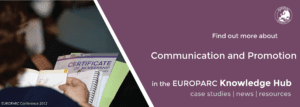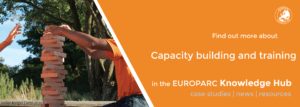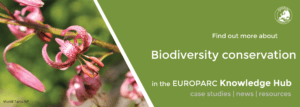Communicating Protected Areas in Europe: a Study Tour outcome
Triglav National Park
Article issued by Baiba Ralle
Every year, the Alfred Toepfer Natural Heritage Scholarship supports the work of young professionals in protected areas across Europe. Baiba was one of the winners of the Scholarship in 2018. Read about her Study Tour, exploring the topic of ‘Communicating Protected Areas in Europe’.
Raising environmental awareness
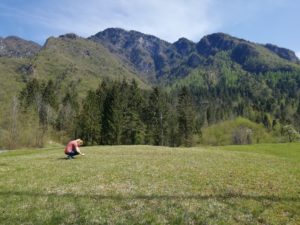
Dolomiti Bellunesi National Park
Communication of protected areas is one of the most important issues nowadays. Since society in its wider sense is the one who directly and indirectly impacts nature conservation processes, only raising its awareness of the importance of nature values can bring sustainable development for future generations. Therefore, managers of protected areas (PAs) are currently in front of an important task to reach human minds in the most effective way to activate their care for ongoing local and national nature processes.
To ensure sustainable development for future generations, society needs to be better aware of the importance of nature.
To improve communication practices of PAs in her country, Latvia, Baiba Ralle made a study tour to four different protected areas in Europe. The objective of the study was to examine how these PAs are organizing communication process, what kind of actions they are proud of and what are the challenges they have to overcome when dealing with this difficult topic.
Watch a short video about her Study Trip:
The study tour was organized in protected landscape area Central Bohemian Uplands in Czech Republic, Saxon Switzerland National Park in Germany, Dolomiti Bellunesi National Park in Italy and Triglav National Park in Slovenia. While visiting PAs, the main interest was to meet PA professionals and discuss their practices in public relations, nature education, society involvement and sustainable tourism.
Despite the situation being very different in different PAs in Europe (administration, financial support and overall governmental system, cultural level, etc.), it turned out that all the territories are facing almost the same challenges which has led to the result of setting up communication work as inseparable unit in official documents dedicated to establishment of PA as a platform of conservation of nature and culture values.
Creativity to overcome lack of finance
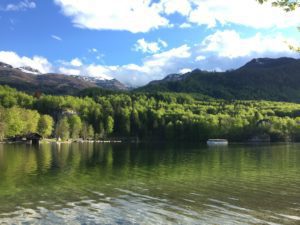
Triglav National Park
One of the biggest challenges in the nature conservation process that all the visited territories are facing and overcoming is insufficient financial support for communication and education activities. Therefore, the study visit has showed that PAs are subjects of creativity and cooperation, of managing and/or supporting different outstanding projects/ methods/ solutions towards more successful /sustainable ways of protecting and conserving nature and cultural values of PAs for coexistence of both – nature and human beings in the future.
PAs use creativity and cooperation to find more successful ways of protecting and conserving nature and cultural values.
All the territories are dealing with the constantly growing number of visitors and struggling/working with solutions to handle such a big number of people coming to the territory for nature recreation and education in very different patterns (mostly active recreation – the biggest threat for nature).
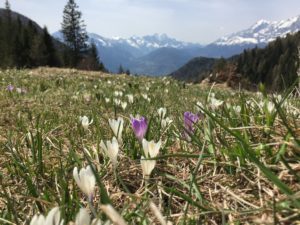
Dolomiti Bellunesi National Park
For all visited territories, biodiversity conservation challenges are crucial, including tireless “translation” work on the topic of nature friendly attitude and behavior towards nature conservation, explaining these matters in popular language that people can relate to and understand, while using PAs facilities.
It is very well done by establishing differently managed information centers and points with different exhibitions, functions and activities, creating brilliant communication campaigns on sustainable tourism matters addressed to wide audience, as well as nature education programs offered for schoolchildren – very important audience who will impact the nature processes in the future.
Innovative nature classes for children
Nature interpretation has become extremely important due to the current situation, when it is very hard to keep children’s attention. Nature education work in all visited PAs tends to walk out of the standardized education systems still implemented at schools, and instead make schoolchildren use all senses during the nature classes – sight, hearing, smell and touch, thus grabbing participants’ attention and reaching the aim of understanding nature and insuring long term conservation and management aims.
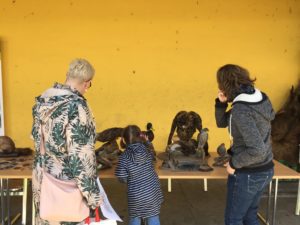
Central Bohemian Uplands, Earth day
Due to lack of human resources, PAs have given great models and examples of how effective in nature education can be cooperation with (1) non-governmental entities, (2) officially established Parks’ Guide network or (3) joint cooperation with university students and some source of funding.
Visited territories have brought evidence and highlighted both the importance of traditional forms of communication still in place, especially regarding communication with local communities (in many territories there is a big issue of constantly aging inhabitants and therefore extreme importance for consumption of traditional media), as well as growing importance of social media in the communication with younger audience – potential PA visitors, living only in this informative space.
Involving local inhabitants
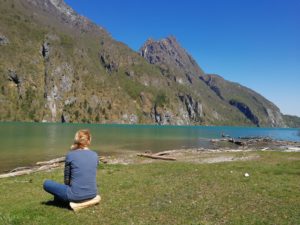
Dolomiti Bellunesi National Park
PAs have also done great efforts regarding local population and economic sectors, trying to reach the aim of locals as conscious members of PA’s structures, feeling the area as a powerful tool to support their business needs and cultural identity, as well as having an empathy and interest for to the protection needs of the territory.
They have showed good example of successful cooperation with local inhabitants within the aim to save Park’s agricultural heritage, as well as to provide local inhabitants the possibility to become volunteer rangers (nature protection guards) of the territory, thus involving local people in the nature awareness raising activities and ensuring their loyalty to the PAs. Another important direction PAs are working towards is sustainable tourism – some efforts include creation of supportive systems for local businesses and producers like quality mark, as well as participation in the European Charter for Sustainable Tourism in Protected Areas.
Overall, the study tour has showed how great communication efforts in different European PAs are being made to change attitudes and behavior of people in the sense of nature conservation step by step, paving the positive outcomes for future generations.
The study has resulted in a full bunch of new tools and ideas, an inspiration to improve communication practices not only at Baiba’s home institution, but also all around Europe, to reach effective improvement of public awareness and sense of ownership of our common natural and cultural heritage, which is the basis for sustainability of any conservation efforts. It is critically important to pass good knowledge from country to country, and connect them for the most positive result in the future.
G-BIKE: 1st Training School in Genomic Biodiversity for Resilient Ecosystems
Source: G-BIKE Website
In a rapidly changing environment, the resilience of ecosystems depends ultimately on species adaptability. G-BIKE aims to provide tools for assessing, monitoring and managing the genetic resilience and related adaptive potential of wild and captive populations in the EU. Applications for the 1st G-BIKE Training School are now open!
Genetics for conservation
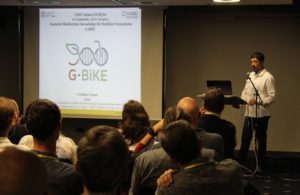
G-BIKE meeting in Sarajevo. Source: G-BIKE Website
Although genetic data can be obtained for most organisms, the standardization of protocols for detecting and monitoring species’ genetic diversity, and their potential for adaptation, is still lacking. G-BIKE hopes to assist scientists and practitioners across the EU, and particularly in COST Inclusiveness Target Countries, to integrate genetic and evolutionary knowledge into conservation planning policies.
Funded by the European Cooperation in Science and Technology (COST), the project also strives to promote cross-border management and long term monitoring programs of evolutionary potential in order to ensure persistence of populations and species, and the continued supply of nature-based ecosystem services.
Apply for the 1st G-BIKE Training School
Applications are now open for the 1st G-BIKE Training School that will be held in La Valletta (Malta) between the 20 and 22 January 2020. The event is entitled ‘Genomic tools for conservation: a practitioner’s guide’ and is mainly, but not exclusively, addressed to practitioners. The aim is to present, in the most comprehensive manner, how can genetics and genomics help to solve practical conservation and management problems.
The ‘Genomic tools for conservation: a practitioner’s guide’ will present, how genetics and genomics can help solving practical conservation and management problems.
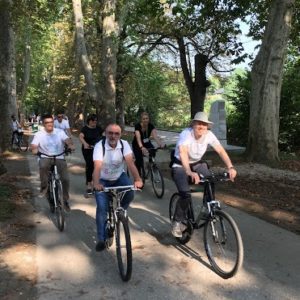
G-BIKE meeting in Sarajevo. Source: G-BIKE Website
The school should also work as a platform for scientists and practitioners to exchange information and ideas, to explore and clarify where and when genomics can make a difference in every day conservation activities within an EU policy and legislative framework. At the beginning, trainees will be asked to offer a short presentation about the main conservation challenges of their current jobs where they think genetic tools might help.
At the end of the School, participants will revisit the presentations and discuss the options and potential strategies that can be applied, using the genomic and analytical tools described during the School.
This School may also be relevant to graduate students about to embark on conservation genomics projects, to help them develop workplans, and just as important, to allow them to make their work policy and management oriented from the outset.
Find more information about the programme and trainers, and apply here before December 8th.
Nature meets art. Or the other way around?
Päivi Tiura People with bathing suits on the beach from not dated
During the Conference 2019 in Latvia, EUROPARC held a number of workshops to discuss diverse topics relevant for Protected Areas management. In case you have not attended, or want to read about their outcomes, a series of online articles summarises the content of some of these workshops.
Nature has always inspired artists – painters, song writers, composers, dancers… Nature is the source of art. Art has been and will be inviting visitors – as individual artists or large groups like choirs – to Protected Areas. Art events at various scales can be arranged inside nature conservation sites to get new visitors to nature or used as a tool to interpret nature to various target audiences.
Art invites visitors to nature
Art may cause interesting controversies among nature and climate conservationists. The peat sculptures made in Latvia are beautiful as art pieces, if you happen to like them (see video). But why do we need to use centuries old carbon sink for art? Well, art has its freedom – we like some and don’t like other pieces of art.
Before we entered the topic of the real life of artists, we heard a presentation from Ms. Sanna-Kaisa Juvonen from Metsähallitus Parks and Wildlife Finland on the kinds of art events that have been organised in Finland. Lighting old castle ruins to depict the story of medieval Raasepori castle ruins was a spectacular way to bring light art into castle ruins (see video).
We also heard Finnish choirs sing the Finlandia hymn by Sibelius at nature day events celebrating the 100th anniversary of Finland (see video above).
During one day, over 1 500 singers performed nature related songs in 37 national parks.
Let’s make some art – it’s easy and fun
Within the workshop, participants were asked to recreate art in two different stages. First we selected over 50 Finnish paintings and asked people to make new interpretations of the paintings they liked in miniature scale using ”Slinkachu” approach. That means they should use small figures, usually used in mini railways.
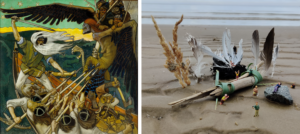
Akseli Gallen-Kallela Defending the Sampo from 1896
After a small break we gave them new instructions: ”now you are people in the paintings”. The same paintings were re-illustrated at full scale. It was easy, creative, and fun!
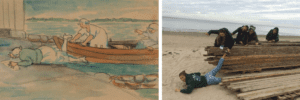
Elin Danielsson On the shore from 1904
We need more chances to talk with artists
As it happens, we are too often comfortably working in our own silos. We agreed in our group that we need to be more courageous and get in contact with artists. We need more platforms for joint discussions with people from different sectors. And also, we could simply invite more artists to our events focusing on nature. Moreover, we know that both creating art e.g. singing and being in nature is good for our mental and physical health. Double win!
Artists get to create art in nature, and we might get new visitors to our sites – interconnecting the nature and art sectors would be mutually beneficial.
It is a bit peculiar that at work we collaborate usually with our colleagues who are also working in the field of nature conservation. But in our private life, we can do very different kind of activities – we sing in choirs, make paintings, write poems, act in local theatre groups. You and your colleagues might actually be amateur artists, but we seldom use art in our work. Perhaps we should?
Let’s be more creative and next time you plan an event, think what role art could play in the event.
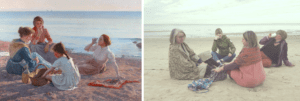
Elin Danielsson On the shore from 1904
Spreading knowledge about butterflies to protect habitats: a case study from Greece
Lycaena ottomanus recorded at Mount Lakmos. Photo: Bisa
Butterflies are good indicators of ecological condition. Based on their occurrence, it is possible to assess change and inform site managers for decision-making. All over Greece, butterfly diversity is very rich and the Tzoumerka National Park decided to make use of this asset to increase environmental awareness of the public and improve habitat protection.
Increasing environmental awareness
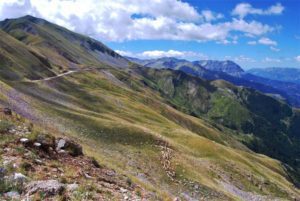
Alpine meadows are important habitats for butterfly species; Mount KATARAXIAS. Photo: BISA
The Tzoumerka Nartional Park is well aware of the fact that rich wildlife in combination with cultural features of the area are great preconditions to make it a thriving ecotourism destination. That is why they aim to obtain a complete list of butterfly species, identify the best sites to apply long term monitoring and protect their habitats.
The park hopes to attract butterfly-watchers and gain recognition as a butterfly destination. Moreover, they organise various activities to sensitise local communities about the importance of wildlife habitat conservation.
All over Greece, butterfly diversity is very rich and many protected and endemic species are recorded in various habitats.
Read the original case study on increasing knowledge about butterfly sites in Tzoumerka National Park, and another case study on monitoring snake populations.
In a nutshell, the project aims to:
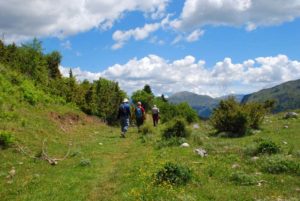
Members of the team visiting new sites near Kakarditsa in 2016. Photo: BISA
- Obtain a complete species-list for butterflies in Tzoumerka NP.
- Identify important areas for the protection of rare/protected species as well as areas with high butterfly diversity.
- Protect important butterfly habitats from anthropogenic threats.
- Contribute to the conservation objectives of the Habitats Directive (Council Directive 92/43/EEC on the Conservation of natural habitats and of wild fauna and flora).
- Attract butterfly-watchers in the NP.
- Raise awareness about butterfly habitats protection in local communities.
Butterfly monitoring
The Park cooperated with a group of experts with long experience on butterflies monitoring. More specifically, the scientific staff of the Park conducted surveys with the help of Lazaros Pamperis, a Greek butterfly expert and members of the Butterfly Conservation – European Interest Group. Surveys were repeated for several years, progressively including more new sites. Finally, a special survey was conducted to monitor Parnassius apollo and Parnassius mnemosyne when their habitats were identified.
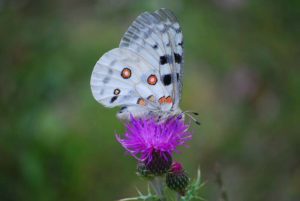
Parnassius apollo recorded at Mount Lakmos. Photo: Rika Bisa
The Park representatives held several meetings to inform local communities about the project. Shepherds were told to collect information about customs and practices related to the use of meadows, and experts in the tourist sector to collect information about visitors. The Park established a partnership with the Environmental Education Centre and organised educational activities to inform schoolchildren about biodiversity.
Once again we rediscovered the importance of sharing information with all the entities and involve experts and local stakeholders to implement conservation measures, protect species and habitats.
Results
Despite challenges such as lack of staff and equipment, which make the realisation of the goals more difficult, some results are already visible. Besides records of many of the winged beauties, important butterfly sites have been identified to apply monitoring projects. The Park established some new trails to enrich ecotourism in the area and began collaboration with local ecotourism agencies to improve its services. Moreover, the data collected helped to prevent habitat deterioration.
Do you have a story of protected area management around Europe that you would like to share as a case study? We will be happy to read it and promote it on our website! Submit your case study here.
